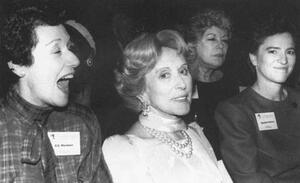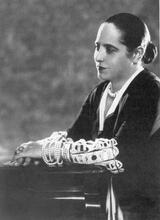Estée Lauder
Estée Lauder became a household name for beauty thanks to the luxurious makeup, lotions, and perfumes she created. Born to a working-class, immigrant family, Lauder was determined to succeed in American society. Her uncle, a chemist who created face creams in his home laboratory, encouraged Lauder to assist him, create her own concoctions, and market products to friends and local salons. Lauder helped pioneer free giveaways and relied on word-of-mouth marketing, but also kept her products in high-end department stores to make them more desirable. In 1964 she launched a new line for men, and later created a fragrance-free line, Clinique. An astute businesswoman, she made a fortune manufacturing, marketing, and distributing cosmetics around the world and was regularly honored for her business achievements.
Estée Lauder’s name connotes beauty and healthy skin through her profitable cosmetics lines: Estée Lauder, Clinique, Aramis, Lauder for Men, and Prescriptives. An astute businesswoman, she made a fortune manufacturing, marketing, and distributing cosmetics to women around the world.
Early Life
Estée Lauder was born Josephine Esther Mentzer in Queens, New York, to Max and Rose (Schotz Rosenthal) Mentzer, a Hungarian immigrant with a French Catholic mother and Jewish father. Rose, who lived until the age of eighty-eight, warned Estée about the harmful effects of the sun; she herself always wore gloves and carried a parasol to guard against its rays. Estée remembered this lesson but also remembered how embarrassed she was by her mother’s parasol and her thick accent, as well as by the immigrant behavior of both her parents. Estée wanted to be one hundred percent American. She was the youngest of the Mentzer children, who grew up Jewish in a mostly Italian neighborhood. Two children had died by the time Estée was born. Her sister Grace, whom the family called Renee, was two years older than Estée.
Her father was a custom tailor but found that he could provide a better living for his family by running a hardware store. Her father’s hardware store provided Estée with merchandising experience. It was her uncle John Shotz, however, who influenced her future business. Shotz was a chemist who created face creams in a makeshift laboratory set up behind her family’s house. He discouraged Estée from using detergent soaps on her face and showed her how to make the cream that, years later, she would improve upon and market under her own name. She launched her cosmetics business during the Depression in New York and later in Miami Beach, Florida.
Estée Lauder remembered an influential experience that had occurred years earlier at a Florence Morris salon in New York City where she sold her products. Lauder recalls in her autobiography (1985) how she admired the blouse of an elegant customer in the salon and asked where she had bought it. The woman scoffed, “What difference could it possibly make? ... You could never afford it.” The young Estée walked away humiliated but vowed that no one would ever say something like that to her again. Some day she would have so much money that she could buy anything she wanted.
Marriage
Estée was about nineteen when she met Joseph Lauter, son of Lillian and William Lauter, immigrants from Galicia. They married on January 15, 1930; their son Leonard Allen was born on March 19, 1933. In about 1937 Estée Lauder began to use the Lauder spelling of her name for her products. Years later in her autobiography she lamented that she neglected her husband and family by paying too much attention to building her business. In 1985 she said, “I did not know how to be Mrs. Joseph Lauder and Estée Lauder at the same time.”
She divorced her husband in 1939 and married him again in 1942. This time their marriage cemented a lifelong bond and launched a business partnership as well. Joseph quit his business to join hers in order to run the factory and deal with production and the finances, while Estée took charge of the sales staff and marketing. Even their son Leonard ran errands for the business. The couple had a second child, Ronald, born in February 1944.
Growing Her Business
Estée Lauder was an exceptionally talented and successful promoter. She was a pioneer in giveaway promotions, always including a lipstick in the gift package. Women tried her products, liked them, and told other women about them. Much of her initial success came from this word-of-mouth advertising. She called her strategy “Tell-a-Woman” marketing. Eventually, she invested in larger marketing concepts, using beautiful models to sell her products. Estée Lauder chose carefully the models for advertising her products, selecting the “Estée Lauder kind of woman,” rather than a movie star. The photographer Victor Skrebneski published a book of his photographs of women who modeled for Estée Lauder products.
Estée Lauder believed in selling her cosmetics at the best department stores, ignoring the advice of her accountant and lawyer, who urged her to get out of this particular business. She started at Saks Fifth Avenue in New York City, an upscale store where women could charge their purchases. After succeeding at Saks Fifth Avenue, she expanded to Neiman Marcus in Dallas, and then several department stores around the country. Estée Lauder opened each store herself and trained the saleswomen who were demonstrating her products.
In 1953, she launched another phase of her business with Youth Dew, a bath oil with a scent that could be used as a perfume. In fact, Lauder said that the product influenced the popularity of perfume at this time. Later she brought out many other popular scents such as Azurée, Aliage, Private Collection, White Linen, Cinnabar, and Beautiful. Lauder, always vigilant about competitors, trusted only family members with formulas for the various fragrances.
Expanding the Market
Lauder decided to venture into the male cosmetic market in 1964, using her son and seven other men in her company to test her products. In 1965, she came out with Aramis and an entire line for men’s skin, which she relaunched in 1967. Another of her creative ideas was the fragrance-free Clinique line, which was launched after extensive medical testing.
Though it took some time, she was eventually able to create a successful European market after correcting her original mistake of bypassing the buyer at Harrods in London. Finally Englishwomen’s demand for Lauder’s cosmetics and the enormously successful Youth Dew body oil cracked the British market. Establishing counter space in good stores in France was even more difficult. She persevered and, by 1985, half of Estée Lauder and related product sales took place in seventy-five foreign countries.
Legacy
At one time, both Leonard and Ronald Lauder, Wharton graduates, contributed to the business, along with their wives, Evelyn and Jo Carole. Leonard Lauder took over as president of Estée Lauder, Inc., in 1973. Ronald Lauder served as chairman of Lauder International, but later left to use his training in government work.
Lauder accumulated enormous wealth through her business acumen. By the late 1980s, with personal assets of $233 million, she was listed by Forbes as one of the four hundred richest Americans. She followed her own admonition: “Measure your success in dollars, not degrees.”
In addition to numerous awards in the cosmetics and fashion industries, Estée Lauder received the French government’s Insignia of Chevalier of the Legion of Honor in 1978, the Gold Medal award of the City of Paris in 1979, the Crystal Apple from the Association for a Better New York in 1977, and the Albert Einstein College of Medicine Spirit of Achievement Award in 1968. In 1970 she was recognized by 575 business and financial editors as one of Ten Outstanding Women in Business. In 1984 she and seven others were chosen as Outstanding Mother of the Year.
A philanthropist, she contributed to National Cancer Care and to the Manhattan League. The Lauder family is also known for charity work in Jewish and other causes.
Estée Lauder died on April 24, 2004, at her home in Manhattan. She was ninety-seven years old.
Selected Works
Estee: A Success Story (1985).
Allen, Margaret. Selling Dreams: Inside the Beauty Business (1981).
Israel, Lee. Estée Lauder: Beyond the Magic (1985).
Kennedy, Trevor. “Estée Lauder.” In Top Guns (1988).
Lauder, Estée. ESTÉE: A Success Story (1985).
Skrebneski, Victor. Five Beautiful Women (1987).
Slater, Elinor, and Robert Slater. “Estée Lauder.” In Great Jewish Women (1994).
Severo, Richard. “Estee Lauder, Pursuer of Beauty and Cosmetics Titan, dies at 97.” New York Times, April 26, 2004, A1.




